|
|
Uruguay: 30.05.- 05.06. & 18.06. -01.07.2007
Distance: 550 Km Ascent: 3400m
Route: Colonia de Sacaramento, Montevideo, Paysandu, Tacuarembo,
Melo, Rio Branco |
| |
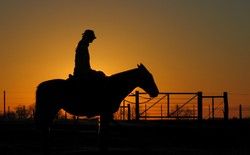 Preface: If you would have asked me 4 years ago, what
I would have known about Uruguay, I would probably have taken a deep
breath to have more time to search somewhere in the well hidden corners
of my brain for some information. After a long long pause I probably
would have told you, that Uruguay must be some "wild" country in Latin-American
(not even sure if Uruguay would be a part of Central- or South America),
heavily involved in producing or smuggling drugs. I couldn't have
been more wrong. Uruguay is a small country opposite of Buenos Aires
on the Rio de la Plata. Nicknamed "Swiss of South America" Uruguay
had according to our guidebook in 2002 with 12000 $US the highest
average income of all countries in South America. Uruguay is mainly
hilly cattle country, with a dairy company as the countries biggest
single enterprise. Even more than in Argentina was and is the Gaucho
culture closely connected with the country, although Punta del Este
is the most popular beach resort of South America. The Uruguayans
have nearly all European forefathers, who came mostly form Italy and
Spain during the 19th century. Thanks to the friendly and helpful
Uruguayans we enjoyed our visit to Uruguay very much. Besides Colonia
des Sacramente and Montevideo we visited the centre of Uruguay, we
there is nothing much to see except huge Estancias. Probably the east
coast and the region along the Rio Uruguay is a bit more interesting.
Bush camping is possible without problems, but because of all the
fences we always had to sleep quite close to the roads, but this wasn't
a big issue as there is not much traffic Preface: If you would have asked me 4 years ago, what
I would have known about Uruguay, I would probably have taken a deep
breath to have more time to search somewhere in the well hidden corners
of my brain for some information. After a long long pause I probably
would have told you, that Uruguay must be some "wild" country in Latin-American
(not even sure if Uruguay would be a part of Central- or South America),
heavily involved in producing or smuggling drugs. I couldn't have
been more wrong. Uruguay is a small country opposite of Buenos Aires
on the Rio de la Plata. Nicknamed "Swiss of South America" Uruguay
had according to our guidebook in 2002 with 12000 $US the highest
average income of all countries in South America. Uruguay is mainly
hilly cattle country, with a dairy company as the countries biggest
single enterprise. Even more than in Argentina was and is the Gaucho
culture closely connected with the country, although Punta del Este
is the most popular beach resort of South America. The Uruguayans
have nearly all European forefathers, who came mostly form Italy and
Spain during the 19th century. Thanks to the friendly and helpful
Uruguayans we enjoyed our visit to Uruguay very much. Besides Colonia
des Sacramente and Montevideo we visited the centre of Uruguay, we
there is nothing much to see except huge Estancias. Probably the east
coast and the region along the Rio Uruguay is a bit more interesting.
Bush camping is possible without problems, but because of all the
fences we always had to sleep quite close to the roads, but this wasn't
a big issue as there is not much traffic |
| |
|
1st visit in Uruguay 30.05. - 05.06.2007
Route: Colonia de Sacaramento, Montevideo
|
| |
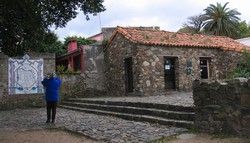 Colonia de Sacramento: Fouded
1680 from the Portuguese, Colonia was an important center to smuggle
English goods over the Rio de la Plata into the Spanish colonies during
the 17th century. The old historical part of the town is quite well
preserved and many buildings from the colonial times are in a pretty
good shape. The old town itself was declared a UESCO world heritage.
After busy and noisy Buenos Aires picturesque Colonia is quite a relief.
We really enjoy strolling through the old town with its small streets,
its museums its cafes and the lighthouse. Colonia de Sacramento: Fouded
1680 from the Portuguese, Colonia was an important center to smuggle
English goods over the Rio de la Plata into the Spanish colonies during
the 17th century. The old historical part of the town is quite well
preserved and many buildings from the colonial times are in a pretty
good shape. The old town itself was declared a UESCO world heritage.
After busy and noisy Buenos Aires picturesque Colonia is quite a relief.
We really enjoy strolling through the old town with its small streets,
its museums its cafes and the lighthouse. |
| |
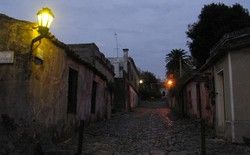 Calle de los Suspiros: In Calle
de los Suspiros one can still find the old cobblestone from the
Portuguese. For us as Germans some old cobblestone is nothing special,
we have it in nearly every better town, but here in South America
well preserved old buildings and streets from the colonial times are
rare. Calle de los Suspiros: In Calle
de los Suspiros one can still find the old cobblestone from the
Portuguese. For us as Germans some old cobblestone is nothing special,
we have it in nearly every better town, but here in South America
well preserved old buildings and streets from the colonial times are
rare. |
| |
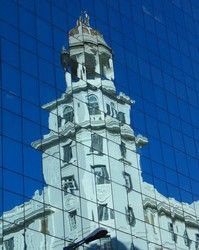 Montevideo: After two quite days
in Colonia we're off to Montevideo, with it's population of 1,3 Mio.
(population of Uruguay 3,6 Mio.), more than just the capital of Uruguay.
Nearly the whole industrial production as well as all imports are
done here and many theatres offer a wide range of cultural entertainment.
Contrary to busy Buenos Aires life seems to be pretty relaxed in Montevideo.
There is not too much traffic and woman and man who walk along the
streets with a thermos bottles under their arm and a mate cup in their
hand are quite common. While Mate is the national drink in Argentina
it seems to bee the elexir of live in Uruguay. Montevideo: After two quite days
in Colonia we're off to Montevideo, with it's population of 1,3 Mio.
(population of Uruguay 3,6 Mio.), more than just the capital of Uruguay.
Nearly the whole industrial production as well as all imports are
done here and many theatres offer a wide range of cultural entertainment.
Contrary to busy Buenos Aires life seems to be pretty relaxed in Montevideo.
There is not too much traffic and woman and man who walk along the
streets with a thermos bottles under their arm and a mate cup in their
hand are quite common. While Mate is the national drink in Argentina
it seems to bee the elexir of live in Uruguay. |
| |
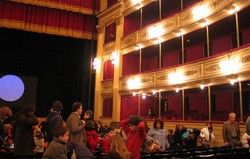 Theatro Solis: Our guidebook suggests a
tour through the Theatro Solis, but instead we visit the performance
of "El Princepito" (The little Prince). The performance was
on Sunday morning and so we sow it with many other kids! Thanks to
our Spanish lessons in Buenos Aires we were able to understand at
least a little bit of the performance! Theatro Solis: Our guidebook suggests a
tour through the Theatro Solis, but instead we visit the performance
of "El Princepito" (The little Prince). The performance was
on Sunday morning and so we sow it with many other kids! Thanks to
our Spanish lessons in Buenos Aires we were able to understand at
least a little bit of the performance! |
| |
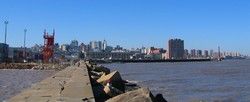 Market day: Every Sunday there is a big
market in Montevideo where one can encounter nearly everything imaginable.
Here one can find not only antiques, trash and handcrafts but also
food, spare parts for cars, pets and furniture. We bought a nice leather
Mate kit. Market day: Every Sunday there is a big
market in Montevideo where one can encounter nearly everything imaginable.
Here one can find not only antiques, trash and handcrafts but also
food, spare parts for cars, pets and furniture. We bought a nice leather
Mate kit. |
| |
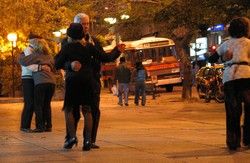 Tango on the street: In the evening we
are on our way to Plaza Fabine where we is supposed to be a Tango
performance. It's already dark and pretty cold when we arrive, but
instead of the expected professional performance there are only some
elderly couples dancing to the Tango Musik from a Cd player. On a
bench next to the "dance floor" are about 10 spectators or potential
dancers. Close to us is a lonely elderly SeŮor who accompanies the
melodies of the Accordion making music on a leaf of grass. He seems
to to be a frequent guest because he knows al the songs very well.
But he stays in the shadow behind a tree, probably because he is ashamed
of his social position. While the rush-hour holds still control over
the main road our dancers get more company and sometimes there are
up to 6 couples on the sidewalk. Between the dancers is a dog which
belongs to nobody. Nobody seems to notice him but at least nobody
is kicking him as well. The group of dancers/spectators seems to know
each other pretty well, because everybody who is arriving is welcomed
warmly, although most of the time there are always the same dancers.
Although they just dance on the sidewalk, most of the dancers are
dressed very formal with suits and dress, but back on the bench they
quickly put on a coat and a hat as it is pretty cold. Just a couple
of minutes before the last song is over the "grass leaf musician"
disappears quietly. Have the dancers realised that he was there? Tango on the street: In the evening we
are on our way to Plaza Fabine where we is supposed to be a Tango
performance. It's already dark and pretty cold when we arrive, but
instead of the expected professional performance there are only some
elderly couples dancing to the Tango Musik from a Cd player. On a
bench next to the "dance floor" are about 10 spectators or potential
dancers. Close to us is a lonely elderly SeŮor who accompanies the
melodies of the Accordion making music on a leaf of grass. He seems
to to be a frequent guest because he knows al the songs very well.
But he stays in the shadow behind a tree, probably because he is ashamed
of his social position. While the rush-hour holds still control over
the main road our dancers get more company and sometimes there are
up to 6 couples on the sidewalk. Between the dancers is a dog which
belongs to nobody. Nobody seems to notice him but at least nobody
is kicking him as well. The group of dancers/spectators seems to know
each other pretty well, because everybody who is arriving is welcomed
warmly, although most of the time there are always the same dancers.
Although they just dance on the sidewalk, most of the dancers are
dressed very formal with suits and dress, but back on the bench they
quickly put on a coat and a hat as it is pretty cold. Just a couple
of minutes before the last song is over the "grass leaf musician"
disappears quietly. Have the dancers realised that he was there? |
| |
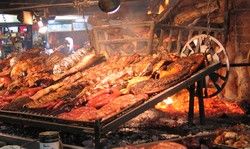 Mercado del Puerto: After the poor Parilla
(BBQ) in Bueino Aires I wanted to give Mum at least once the opportunity
to test the famous south American steaks. The steaks in Uruguay are
probably even better than the ones in Argentina, thanks to better
grass an no supplementary feeding),and to taste it we went to Mercado
del Puerto. The old harbour market is located in an 19th century
building and is crowded with many restaurants who all prepare their
steaks straight in front of our eyes on grills fired with real wood.
While I enjoy a grilled cheese my Mum ordered a bife de lomo,
a beefsteak. She enjoyed her bife de lomo so much, that
she surely would have ordered another one, wouldn't it have been that
big! Mercado del Puerto: After the poor Parilla
(BBQ) in Bueino Aires I wanted to give Mum at least once the opportunity
to test the famous south American steaks. The steaks in Uruguay are
probably even better than the ones in Argentina, thanks to better
grass an no supplementary feeding),and to taste it we went to Mercado
del Puerto. The old harbour market is located in an 19th century
building and is crowded with many restaurants who all prepare their
steaks straight in front of our eyes on grills fired with real wood.
While I enjoy a grilled cheese my Mum ordered a bife de lomo,
a beefsteak. She enjoyed her bife de lomo so much, that
she surely would have ordered another one, wouldn't it have been that
big!
|
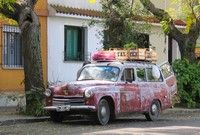 Returning to Buenos Aires: After six lovely
days in Uruguay we returned to BsAs. Thanks to some "good" connections
we left Montevideo at 1am, changed to the ferry at 4am and arrived
pretty tired in Buenos Aires at 7:30am! Returning to Buenos Aires: After six lovely
days in Uruguay we returned to BsAs. Thanks to some "good" connections
we left Montevideo at 1am, changed to the ferry at 4am and arrived
pretty tired in Buenos Aires at 7:30am! |
| |
2nd visit in Uruguay: 18.06. - 01.07.2007
|
|
Route: Paysandu, Tacuarembo, Melo, Rio Branco
|
| |
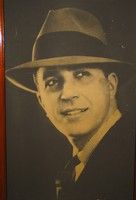 Carlos Gardel: Carlos Gardel, probably
the most famous tango singer ever, was born on a estancia close to
Tacuarembo at the end of the 19th century. Before he died on
an airplane accident in 1935 in Colombia he became so famous all over
the world that besides Uruguay also Argentina and even France declared
him a national hero. Here in Valle Eden close to Tacuarembo
not far from his fathers estancia is a small museum to honour the
great Uruguayan singer. To confirm his Uruguayan origin the museum
hosts besides many photos from Carlos Gardel also all his documents
(passport ...) and many newspaper articles. We nearly get the impression
that confirming his Uruguayan origin is the sole purpose of the museum. Carlos Gardel: Carlos Gardel, probably
the most famous tango singer ever, was born on a estancia close to
Tacuarembo at the end of the 19th century. Before he died on
an airplane accident in 1935 in Colombia he became so famous all over
the world that besides Uruguay also Argentina and even France declared
him a national hero. Here in Valle Eden close to Tacuarembo
not far from his fathers estancia is a small museum to honour the
great Uruguayan singer. To confirm his Uruguayan origin the museum
hosts besides many photos from Carlos Gardel also all his documents
(passport ...) and many newspaper articles. We nearly get the impression
that confirming his Uruguayan origin is the sole purpose of the museum. |
| |
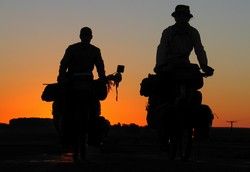 Towards the sun: The sunsets in the Pampa
in Argentina and in Uruguay are sometimes really extra Towards the sun: The sunsets in the Pampa
in Argentina and in Uruguay are sometimes really extra |
| |
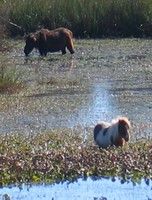 Wet paddock: Some horses seem to enjoy
especially the very wet grass. Wet paddock: Some horses seem to enjoy
especially the very wet grass. |
| |
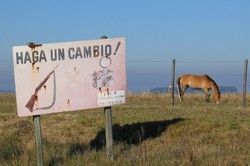 HAGA UN CAMBIO: "Make a change!" and shoot
a photo of the animals instead of shooting them with a rifle. HAGA UN CAMBIO: "Make a change!" and shoot
a photo of the animals instead of shooting them with a rifle. |
| |
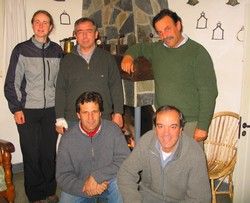 Visiting an Estancia: In the middle of
nowhere Labido (front right) invites us to his Estancia. Normally
Labido lives with his family in Montivideo (where he also works for
the biggest company of Uruguay), but he owns three Estancias out here
which are run by his administrator (standing right). Each fortnight
Labido is visiting his Estancias to check everything and to discuss
some details with the independent agriculture specialists. We arrived
at lunchtime at the estancia and together with the administrator,
Juan an argentine agriculture specialist for Soy (front left) and
Jaime (standing left) we are invited for lunch. We quickly realise,
that we are not together with some simple farmers. Not only that we
are able to talk with them in English but Labido, Juan and Jaime have
also a huge knowledge about many place we have visited (including
all the backgrounds), which means that we have to search deep in our
brains to find the answers for the sometimes pretty tough questions.
We expected everything in the middle of Uruguay, where the are cattle
farms as far as you can look (and beyond), but not some people who
recognised the bridge of Novi Sad (Serbia) which was destroyed 1999
by the USA from a photo and who also knew, that the sweet water dolphins
in the Ganges river have some very long noses. Later we learned that
Labido used to be a member of a delegation around the President of
Uruguay during a visit to Dubai. Labido invites us to spend the night
at his Estancia and we are happy to spent more time with this interesting
gentlemen. Visiting an Estancia: In the middle of
nowhere Labido (front right) invites us to his Estancia. Normally
Labido lives with his family in Montivideo (where he also works for
the biggest company of Uruguay), but he owns three Estancias out here
which are run by his administrator (standing right). Each fortnight
Labido is visiting his Estancias to check everything and to discuss
some details with the independent agriculture specialists. We arrived
at lunchtime at the estancia and together with the administrator,
Juan an argentine agriculture specialist for Soy (front left) and
Jaime (standing left) we are invited for lunch. We quickly realise,
that we are not together with some simple farmers. Not only that we
are able to talk with them in English but Labido, Juan and Jaime have
also a huge knowledge about many place we have visited (including
all the backgrounds), which means that we have to search deep in our
brains to find the answers for the sometimes pretty tough questions.
We expected everything in the middle of Uruguay, where the are cattle
farms as far as you can look (and beyond), but not some people who
recognised the bridge of Novi Sad (Serbia) which was destroyed 1999
by the USA from a photo and who also knew, that the sweet water dolphins
in the Ganges river have some very long noses. Later we learned that
Labido used to be a member of a delegation around the President of
Uruguay during a visit to Dubai. Labido invites us to spend the night
at his Estancia and we are happy to spent more time with this interesting
gentlemen. |
| |
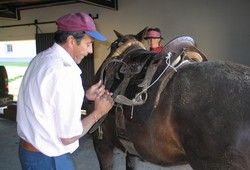 Visiting an Estancia part 2: Generally
life on an Estancia an Uruguay is still pretty traditional. The fore
worker took his hat when he was presented to us und Lapido showed
everybody his place on the table. The cows here in the heart of Uruguay
are probably some of the few really happy cows in the world, as they
are allowed to spend their entire life on the paddocks (1ha for 1
cow) and are not fed with supplementary food to grow faster (injections
to support fast rowing are also unthinkable). The Farmers are willing
to accept hat the cows loose about 30 Km each winter to maintain the
good quality of meat and stables are as alien here as the mass production
of meet. Labido has to take care of some things during his time out
here and so he asks one of his gauchos too show us the Estancia and
to give us a horse for riding. So we are able to se not only the vegetable
garden and the scale to weigh to cows, but also the accommodation
of the gauchos. Here we see with our own eyes that a gaucho has really
noting more than his clothes and his Mate cup. At least we havenít
seen much more than one TV and one radio for 6 gauchos. (Not even
a wardrobe) Visiting an Estancia part 2: Generally
life on an Estancia an Uruguay is still pretty traditional. The fore
worker took his hat when he was presented to us und Lapido showed
everybody his place on the table. The cows here in the heart of Uruguay
are probably some of the few really happy cows in the world, as they
are allowed to spend their entire life on the paddocks (1ha for 1
cow) and are not fed with supplementary food to grow faster (injections
to support fast rowing are also unthinkable). The Farmers are willing
to accept hat the cows loose about 30 Km each winter to maintain the
good quality of meat and stables are as alien here as the mass production
of meet. Labido has to take care of some things during his time out
here and so he asks one of his gauchos too show us the Estancia and
to give us a horse for riding. So we are able to se not only the vegetable
garden and the scale to weigh to cows, but also the accommodation
of the gauchos. Here we see with our own eyes that a gaucho has really
noting more than his clothes and his Mate cup. At least we havenít
seen much more than one TV and one radio for 6 gauchos. (Not even
a wardrobe) |
| |
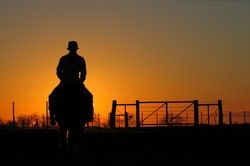 Riding lessons: Nadine made her first riding
experiences a park called LochmŁhle, where the horse was walked around
by her mother. After a long break experiences on camel (Egypt), Donkey
(Egypt) and elephant (Thailand) followed. Now, after another big break
Nadine has finally the change to return to horse riding, as Labido
offered us to use one of his horses. While until now always someone
else took care that the riding animal behaved well Nadine was now
on her own, after the Gaucho had disappeared shortly after the horse
was saddled. The question how to tell the horse to start walking solved
the horse on its own and walked straight back to its paddock. Now
the Gaucho returns to rescue Nadine, brings the horse back to the
front yard and closes wisely the gate to the paddock! Nadine used
her change and asked the Gaucho about the name of the horse, but the
answer was unexpected: "The horse has no name - its just a horse!"
It seems that the relationship between the Gaucho and his horse is
not too special. But again he didn't tell Nadine how to handle the
horse. After "talking to the horse", "wobbling" and "pulling at the
reins" all didn't work the only thing left to do was to use the rebenque,
the short whip of the Gauchos. Slowly the horse started walking
although not to enthusiastically. After a while, after she had stopped
to pull on the reins, Nadine managed to ride with the horse in whatever
direction she wanted. Finally after about 1,5 h was already pretty
good and handled horse very well. The only thing which stopped Nadine
not to ride straight into the sunset was the fence, because jumping
is part of the next riding lesson! :-) Riding lessons: Nadine made her first riding
experiences a park called LochmŁhle, where the horse was walked around
by her mother. After a long break experiences on camel (Egypt), Donkey
(Egypt) and elephant (Thailand) followed. Now, after another big break
Nadine has finally the change to return to horse riding, as Labido
offered us to use one of his horses. While until now always someone
else took care that the riding animal behaved well Nadine was now
on her own, after the Gaucho had disappeared shortly after the horse
was saddled. The question how to tell the horse to start walking solved
the horse on its own and walked straight back to its paddock. Now
the Gaucho returns to rescue Nadine, brings the horse back to the
front yard and closes wisely the gate to the paddock! Nadine used
her change and asked the Gaucho about the name of the horse, but the
answer was unexpected: "The horse has no name - its just a horse!"
It seems that the relationship between the Gaucho and his horse is
not too special. But again he didn't tell Nadine how to handle the
horse. After "talking to the horse", "wobbling" and "pulling at the
reins" all didn't work the only thing left to do was to use the rebenque,
the short whip of the Gauchos. Slowly the horse started walking
although not to enthusiastically. After a while, after she had stopped
to pull on the reins, Nadine managed to ride with the horse in whatever
direction she wanted. Finally after about 1,5 h was already pretty
good and handled horse very well. The only thing which stopped Nadine
not to ride straight into the sunset was the fence, because jumping
is part of the next riding lesson! :-) |
| |
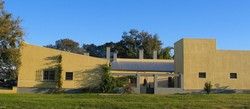 Slideshow: Before and after dinner (rice with black
beans and beef) we have the change to show our pictures on the small
TV of the Gauchos. I think the Gauchos had no glue what was about
to happen when we suddenly stood with 6 people in their common room.
Labido greeted all of them with a handshake and introduced us. Then
he asked them if we could use their TV and also invited them to join
us if they would like to. As 3-4 Gauchos are interested to see the
photos itís for me now the first time that I have to present the photos
in Spanish, but thanks for Juan the Argentine, who helps me out in
all the difficult parts it works quit good. Due to my difficulties
with Spanish and due to the dinner break we leave immediately after
the last picture was shown, because the Gauchos have to start working
long before sunrise. Slideshow: Before and after dinner (rice with black
beans and beef) we have the change to show our pictures on the small
TV of the Gauchos. I think the Gauchos had no glue what was about
to happen when we suddenly stood with 6 people in their common room.
Labido greeted all of them with a handshake and introduced us. Then
he asked them if we could use their TV and also invited them to join
us if they would like to. As 3-4 Gauchos are interested to see the
photos itís for me now the first time that I have to present the photos
in Spanish, but thanks for Juan the Argentine, who helps me out in
all the difficult parts it works quit good. Due to my difficulties
with Spanish and due to the dinner break we leave immediately after
the last picture was shown, because the Gauchos have to start working
long before sunrise. |
| |
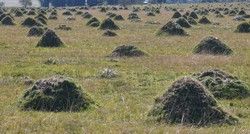 Huge molehills: We saw
here in Uruguay some huge molehills. Some of the molehills were so
big, that a sheep nearly disappeared behind them. Unfortunately we
never saw the animal which made these small mountains. Huge molehills: We saw
here in Uruguay some huge molehills. Some of the molehills were so
big, that a sheep nearly disappeared behind them. Unfortunately we
never saw the animal which made these small mountains. |
| |
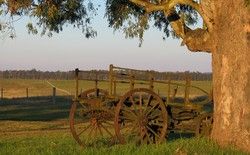 Departure: Our departure form Uruguay and our Entry
in Brazil was rather unusual. First the Immigration in Uruguay was
already before the last town. After we got our departure stamp we
cycle through Rio Branco, the last town in Uruguay, cross a bridge
into Brazil but a Immigration office is nowhere to see. We ask some
customs officers who seem to bee on the bridge by accident where we
could obtain our Brazilian entry stamp and are directed to the Federal
police somewhere in town. We are cycling quite awhile through Jaguarao
until we finally manage to find the police station. Through the closes
curtain of an open window in the police station a policeman takes
our passports and returns them, correctly stamped, after a couple
of minutes with the words "Welcome to Brazil!" Fortunately we never
had such an unorganized border crossing at the beginning of our trip
because surely would have forgotten to obtain our entry stamp for
Brazil. Departure: Our departure form Uruguay and our Entry
in Brazil was rather unusual. First the Immigration in Uruguay was
already before the last town. After we got our departure stamp we
cycle through Rio Branco, the last town in Uruguay, cross a bridge
into Brazil but a Immigration office is nowhere to see. We ask some
customs officers who seem to bee on the bridge by accident where we
could obtain our Brazilian entry stamp and are directed to the Federal
police somewhere in town. We are cycling quite awhile through Jaguarao
until we finally manage to find the police station. Through the closes
curtain of an open window in the police station a policeman takes
our passports and returns them, correctly stamped, after a couple
of minutes with the words "Welcome to Brazil!" Fortunately we never
had such an unorganized border crossing at the beginning of our trip
because surely would have forgotten to obtain our entry stamp for
Brazil. |
|
|
I
BOOKLET
available
for
DONATION!

50pages, 80 b/w photos, background
infos, stories, ...
Just send your donation
to our
Pay
Pal account: nadinepuschkasch@yahoo.de
and email us your post
address and we´ll send it to you.
|
| |
| |
|
Like to place your Ad here?
Just e-mail to:
martinlunz@yahoo.de
|
| |
| |
|
You
liked our website and like to contribute?
Our Pay
Pal account is: nadinepuschkasch@yahoo.de
|
|
| |
|
